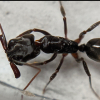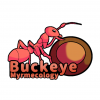Here’s what I wrote on another thread. Keep in mind I’m not sure how much of this applies for C. mississippiensis, which nests within living plants and probably appreciates considerably more humidity.
Colobopsis impressa is one of the better known species in the genus, and they can be very common within their range. In my area, I routinely attract hundreds of alates utilizing blacklights during the first very warm and humid nights in late May and June. I’ve found them most common in and near mature hardwood forests with fairly mesic conditions, but they can persist in a wide variety of habitat types so long as they have plenty of arboreal nesting opportunities in the form of dead branches/twigs, or plenty of vines scaling up into the canopy.
Their diet in the wild seems to be exclusively liquid. I’ve seen workers in close association with honeydew producing Hemiptera and have frequently seen them feeding on bird droppings along low lying branches. Colonies are small, with no more than 250 workers and a few dozen majors in the largest nest.
Here’s an excerpt from Ants of Florida: Identification and Natural History, by Mark Deyrup:
“Colonies may only persist for a few years, judging by the size of field colonies and the longevity of laboratory colonies. Suitable nesting sites may be limited, and dead twigs are subject to breakage, circumstances that may give an evolutionary advantage to lineages that invest heavily in reproduction and less in long-term maintenance. The number of reproductives is correlated in this study with the number of majors, possibly because the food-storing majors maintain food supplies during the time reproductives are larvae. All this may mean that colonies end up somewhat understaffed with foragers.”
Captive care for the species usually begins with freshly caught queens. Something important to note is that dealates can be uncommon finds, and queens only occasionally remove their wings once captured. Despite this, they’re usually fertile if they’ve appeared at a light. I suspect arboreal ants such as them often continue to fly long after they’ve mated, until they locate an elevated position deemed suitable before removing their wings.
Queens can found together via pleometrosis, but I’ve never attempted such a setup and am unaware of how it’d go long term; all the founding/mature colonies I’ve seen or captured have always been monogynous. Queens can be started in standard test tube setups, but they truly appreciate as cramped a founding nest as possible. If provided with such, they’re usually quick to lay eggs. (Otherwise, they can take weeks) My favorite method of founding them is simple and utilizes glass blowing tubes with one end plugged with a wad of hot glue, (as blowing tubes are open ended) and the other end capped with cotton. I provide no water reservoir—this species, like many arboreal ants, is highly tolerant to desiccation—but I try to feed the queens carbohydrates before I put them away for founding. I’ll usually check a few times during the founding process and offer them water/sugar water on a piece of foil pushed into the tube with a thin metal wire, but only if the queens are looking thin.
The first brood is small and usually consists of 2-4 workers, but it’s easy sailing once they’ve arrived. I offer the first workers a sugar meal in the tube as soon as they will take one, and then immediately remove the cotton plug and install an entrance. To do so I simply hot-glue a thin piece of firm cardboard (like the type cereal boxes are made of, but avoid any pieces with inks/dyes) cut to size to fit flush over the tube opening. I poke a 1-1.5mm wide hole in the middle (this entrance will allow the observation of door-guarding behavior when the first major arrives, and even the queen will guard in very young colonies) and then place the entire tube in an appropriately sized foraging container, preferably in an elevated position to simulate an arboreal nest.
They need no additional nest humidity at all, but it’s important to provide fresh water in the outworld at all times using a test tube or byformica feeder. Workers will collect it at will, and the queen/majors serve as liquid stores. Diet should consist of frequent carbohydrate feedings (sugar/honey water, byformica sunburst, etc.) and crushed insects. (Crickets, mealworms, roaches, fruit flies, etc.) Insect hemolymph is mined out of dead prey provided in the outworld and the majority of protein is taken back to the nest in liquid form. Dry/uncrushed insects are often ignored, so accessible liquids should be prioritized when feeding solid foods for best success.
In the large colonies I have sustained to maturity, I also provided fresh bird droppings (from my pet conure; feces from granivorous/frugivorous birds seem preferred) every week, the liquids in which were avidly imbibed. Tree frog feces also seems to work well. If you’re feeling adventurous, human urine (sourced from someone non-medicated, on a healthy diet) can serve as a suitable urea substitute. They may or may not do just fine without any urea in the form of bird feces/human urine, especially if one feeds lots of roaches. (Which have large uric acid stores)
In much of their range they will need to be provided a winter dormancy, during which brood production either halts or slows down dramatically. The length and intensity of such will depend on the locale the queen originates from. I do so by moving mine to a cool corner of the house where temperatures average 68-72 degrees during the night/day, but only when the coinciding outside temperature drops have allowed for cooler temperature indoors. (All my ants are exposed to consistent 75-78 degree temps during the growing season) Ants from colder climates may need significantly lower temperatures for healthy dormancy.
I’ve only attempted to rear a handful of Colobopsis colonies long term, (truth be told, I usually lose interest in them fairly quickly) but the ones I’ve used the above methods on have had a near perfect success rate. By the time they approach the 12 month mark the next year, they have had 100+ workers and were in the process of rearing dozens of alates.
Glass blowing tubes:
https://www.ebay.com...lcAAOSw4CFY10Cq
Edited by 123LordOfAnts123, July 10 2020 - 9:23 AM.




















